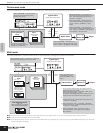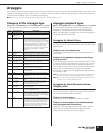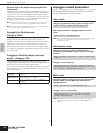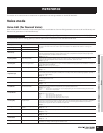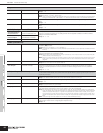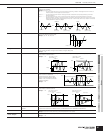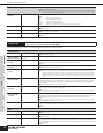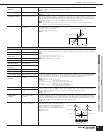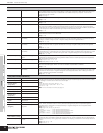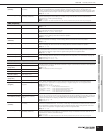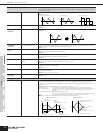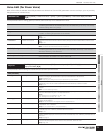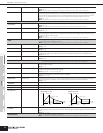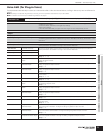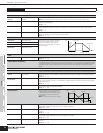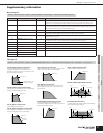
Owner’s Manual
Utility
Voice mode
Performance mode Multi mode Effect Arpeggio
Reference
Voice mode Voice Edit (for Normal Voice)
70
Filter
Type
Filter Type Makes comprehensive settings for the Filter unit. Parameters will vary according to the Type. Basically, there
are four different filters: an LPF (Low Pass Filter), an HPF (High Pass Filter), a BPF (Band Pass Filter) and a
BEF (Band Elimination Filter). Each available filter has a different frequency response. There are also
combinations of LPF and HPF.
Settings: See page 77.
Gain
Filter Gain Sets the Gain (the amount of boost applied to the signal sent to the Filter Unit).
Settings: 0 ~ 255
Cutoff
Filter Cutoff Sets the cutoff frequency. This is used as the basic frequency for the selected Filter Type.
Settings: 0 ~ 255
Resonance (Reso)
Filter Resonance This parameter’s function varies according to the selected Filter Type. If the selected filter is an LPF, HPF,
BPF (excluding the BPFw), or BEF, this parameter affects the amount of resonance. This can be used in
combination with the “Cutoff” parameter to add further character to the sound. With the BPFw, the parameter
is used to adjust the width of the band of signal frequencies passed by the filter.
Settings: 0 ~ 127
Distance (Dstnce)
Filter Distance Determines the distance between the Cutoff Frequencies, for the Dual Filter types (two filters connected in
parallel fashion) and the LPF12+BPF6 filter.
Settings: 0 ~ 255
CutofVelSns (CtofVl)
Filter Cutoff Velocity
Sensitivity
Determines the degree to which velocity affects the Cutoff Frequency of the Filter EG. Positive settings will
cause the Cutoff Frequency to become higher when you play the notes harder (for a large Velocity value),
resulting in a drastic change in tones. A negative setting will have the opposite effect.
Settings: -64 ~ 0 ~ +63
ResoVelSns (ResoVl)
Filter Resonance Velocity
Sensitivity
Determines the degree to which velocity affects the Resonance of the Filter EG. For positive values, the
harder you play the notes, the greater the Resonance change. A negative setting will have the opposite
effect.
Settings: -64 ~ 0 ~ +63
FlwFltSns (FlwSns)
Filter Cutoff Key Follow
Sensitivity
Determines the degree to which the notes (specifically, their position or octave range) affect the Filter of the
selected Element. A Cutoff setting of C3 is used as the basic setting. A positive setting will lower the Cutoff
Frequency for lower notes and raise it for higher notes. A negative setting will have the opposite effect.
Settings: -200 ~ 0 ~ +200
ScaleBP1-4 (BP1-4)
Filter Cutoff Scaling Break
Point
Filter Scaling controls the Filter Cutoff Frequency according to the note numbers. You can divide the entire
keyboard by four break points, and assign different offset values of Cutoff Frequency to them respectively.
Refer to the setting example on 78.
Settings: BP (Break Point) 1-4: C-2 ~ G8
Settings: Ofset (Offset)1-4: -128 ~ 0 ~ +127
ScaleOfst1-4 (Ofst1-4)
Filter Cutoff Scaling Offset
HPF Cutoff (HPCtof)
HPF Cutoff Determines the central frequency for the “HPF FlwSns” parameter below.
When one of the filter types “LPF12” or “LPF6” is selected, this parameter is available.
Settings: 0 ~ 255
HPF FlwSns (HP Flw)
HPF Cutoff Key Follow
Sensitivity
Sets the Key Follow for the frequency of the “HPF Cutoff” parameter. This parameter varies the center
frequency according to the note numbers. A positive setting will raise the center frequency for higher notes
and lower it for lower notes. A negative setting will have the opposite effect. When a filter type “LPF12” or
“LPF6” is selected, this parameter is available.
Settings: -200 ~ 0 ~ +200
FEG (Filter Envelope Generator)
HoldTime (HoldTm)
FEG Hold Time Makes all the time and level settings for the Filter EG, which determine how the tonal quality of the sound
changes over time. These can be used to control the change in Cutoff Frequency from the moment a Note
On message is received to the moment the sound stops.
Settings:
HoldTm, AtkTm, Dcy1Tm, Dcy2Tm, RelTm: 0 ~ 127
HoldLv, AtkLv, Dcy1Lv, Dcy2Lv, RelLv: -128 ~ 0 ~ +127
Depth -64 ~ 0 ~ +63
n For more information on the FEG, see page 56.
AttackTime (AtkTm)
FEG Attack Time
Decay1/2Time
(Dcy1/2Tm)
FEG Decay Time
ReleaseTime (RelTm)
FEG Release Time
HoldLvl (HoldLv)
FEG Hold Level
AttackLvl (AtkLv)
FEG Attack Level
Decay1/2Lvl
(Dcy1/2Lv)
FEG Decay Level
ReleaseLvl (RelLv)
FEG Release Level
Depth
FEG Depth
EGTmVelSns (TmVel)
FEG Time Velocity Sensitivity Determines the velocity sensitivity of the FEG’s Time parameters. First select the “Segmnt” (Segment), then
set its “TmVel” parameter. Positive “TmVel” parameter settings will play back the specified Segment
parameter faster in proportion to the played velocity. A negative setting will have the opposite effect.
Settings: TmVel: -64 ~ 0 ~ +63
Settings: Segmnt: atk, atk+dcy, dcy, atk+rls, all
atk (attack) ............................“TmVel” parameter affects Attack time.
atk+dcy (attack + decay)......“TmVel” parameter affects Attack/Decay1 time.
dcy (decay)...........................“TmVel” parameter affects Decay time.
atk+rls (attack + release.......“TmVel” parameter affects Attack/Release time.
all...........................................“TmVel” affects all FEG Time parameters.
SgmntVelSns
(Segmnt)
FEG Time Velocity Sensitivity
Segment
EGLvVelSns (LvlVel)
FEG Velocity Level Sensitivity Determines the velocity sensitivity of the FEG Level. Positive settings will cause the level to rise the harder
you play the note, and negative values will cause it to fall. The “CrvVel” parameter lets you select from five
different preset velocity curves (graphically indicated in the display), that determine how velocity affects the
“LvlVel.”
Settings: LvlVel: -64 ~ 0 ~ +63
Settings: CrvVel: 0 ~ 4
CurvVelSns (CrvVel)
FEG Velocity Sensitivity
Curve



